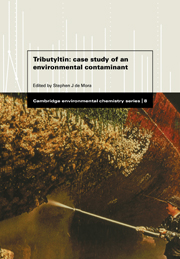Book contents
- Frontmatter
- Contents
- Contributors
- Preface
- 1 The tributyltin debate: ocean transportation versus seafood harvesting
- 2 Industrial manufacture and applications of tributyltin compounds
- 3 The analysis of butylated tin compounds in the environment and in biological materials
- 4 The occurrence, fate and toxicity of tributyltin and its degradation products in fresh water environments
- 5 The distribution and fate of tributyltin in the marine environment
- 6 Biological effects of tributyltin on marine organisms
- 7 TBT-induced imposex in neogastropod snails: masculinization to mass extinction
- 8 Environmental law and tributyltin in the environment
- 9 The efficacy of legislation in controlling tributyltin in the marine environment
- Index
6 - Biological effects of tributyltin on marine organisms
Published online by Cambridge University Press: 04 August 2010
- Frontmatter
- Contents
- Contributors
- Preface
- 1 The tributyltin debate: ocean transportation versus seafood harvesting
- 2 Industrial manufacture and applications of tributyltin compounds
- 3 The analysis of butylated tin compounds in the environment and in biological materials
- 4 The occurrence, fate and toxicity of tributyltin and its degradation products in fresh water environments
- 5 The distribution and fate of tributyltin in the marine environment
- 6 Biological effects of tributyltin on marine organisms
- 7 TBT-induced imposex in neogastropod snails: masculinization to mass extinction
- 8 Environmental law and tributyltin in the environment
- 9 The efficacy of legislation in controlling tributyltin in the marine environment
- Index
Summary
A number of marine ecotoxicology studies devoted to TBT were initiated in the early 1980s following the harmful effects observed in oyster-growing areas, initially in France and later in Great Britain. This background implies that most of the data relate to mollusc shellfish, regarded as target species.
Bioaccumulation and metabolism
The presence of alkyl groups on the tin atom of TBT leads to an increase in its lipophilic properties, and thereby in an increased capacity to become bioaccumulated in living organisms. Theoretically, the octanol/water partition coefficient (Kow) provides the possibility of calculating the bioconcentration factor (BCF).
In the case of TBTO, Laughlin, French & Guard (1986) have shown that for salinity values ranging from 0 to 25 psu, Kow values vary between 7000 and 6000 respectively, while for higher salinity they range between 5000 and 6300. The above values are markedly higher than the value of 1550 found by Maguire, Carey & Hale (1983) in distilled water. Such disparity between Kow values leads to considerable uncertainties regarding the bioconcentration factor (BCF) calculated on the basis of various correlation equations. Thus, the equation of Veith, Defoe & Bergstedt (1979) (log BCF = −0.70 + 0.85 log Kow) would lead to a TBTO bioconcentration in freshwater fish ranging from approximately 100 (Kow = 1550) to 370 (Kow = 7000). Based on the equation of Mackay (1982), the BCF would range between 400 and 500.
- Type
- Chapter
- Information
- TributyltinCase Study of an Environmental Contaminant, pp. 167 - 211Publisher: Cambridge University PressPrint publication year: 1996
- 25
- Cited by

